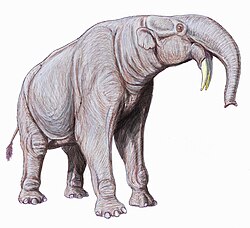Deinotheriidae
| Deinotheriidae Temporal range: Late Oligocene–Pleistocene |
|
|---|---|
 |
|
| Deinotherium | |
| Scientific classification | |
| Kingdom: | Animalia |
| Phylum: | Chordata |
| Class: | Mammalia |
| Order: | Proboscidea |
| Suborder: | †Deinotherioidea |
| Family: |
†Deinotheriidae Bonaparte, 1845 |
| Genera | |
|
Subfamily †Chilgatheriinae Subfamily †Deinotheriinae |
|
 |
|
| The inferred range of Deinotheriidae | |
Subfamily †Chilgatheriinae
Subfamily †Deinotheriinae
Deinotheriidae ("terrible beasts") is a family of prehistoric elephant-like proboscideans that lived during the Cenozoic era, first appearing in Africa, then spreading across southern Asia (Indo-Pakistan) and Europe. During that time they changed very little, apart from growing much larger in size; by the late Miocene they had become the largest land animals of their time. Their most distinctive feature was the downward curving tusks on the lower jaw.
Deinotheres were not very diverse; there are only three known genera: Chilgatherium, Prodeinotherium and Deinotherium. These form an evolutionary succession with each new genus replacing the preceding one.
Unlike the various mammoth and mastodont lineages, the deinotheres died out in the early Pleistocene, rather than continuing through the ice age.
The body shape and proportions of deinotheres were very much like those of modern elephants. The legs were long, like modern elephants, but the skull was rather flatter than that of true elephants. The upper jaw lacked incisor and canine teeth, but possessed five low-crowned molars on each side, with the same number in the lower jaw. Research has shown that deinotheres used their front teeth for crushing their food, and the back teeth for shearing (slicing), the plant material.
The front part of the lower jaw was turned downwards, and bore the two tusk-like incisors. These curved downwards and backwards in a sort of huge hook, and constituted the most distinct feature of the deinotheres. The tusks were used to strip vegetation rather than for digging.
Deinotheres were "shearing browsers" adapted for feeding on plants above ground level. The way they chewed their food was probably similar to that of modern tapirs, with the front teeth being used to crush the food, while the second and third molars have a strong vertical shearing action, with little lateral (side to side) movement. This chewing action differs from both that of gomphotheres (lateral grinding) and elephants (horizontal shearing). Deinothere molars show little wear, indicating a diet of soft, nongritty, forest vegetation, with the down-turned lower tusks being used for stripping bark or other vegetation.
...
Wikipedia
